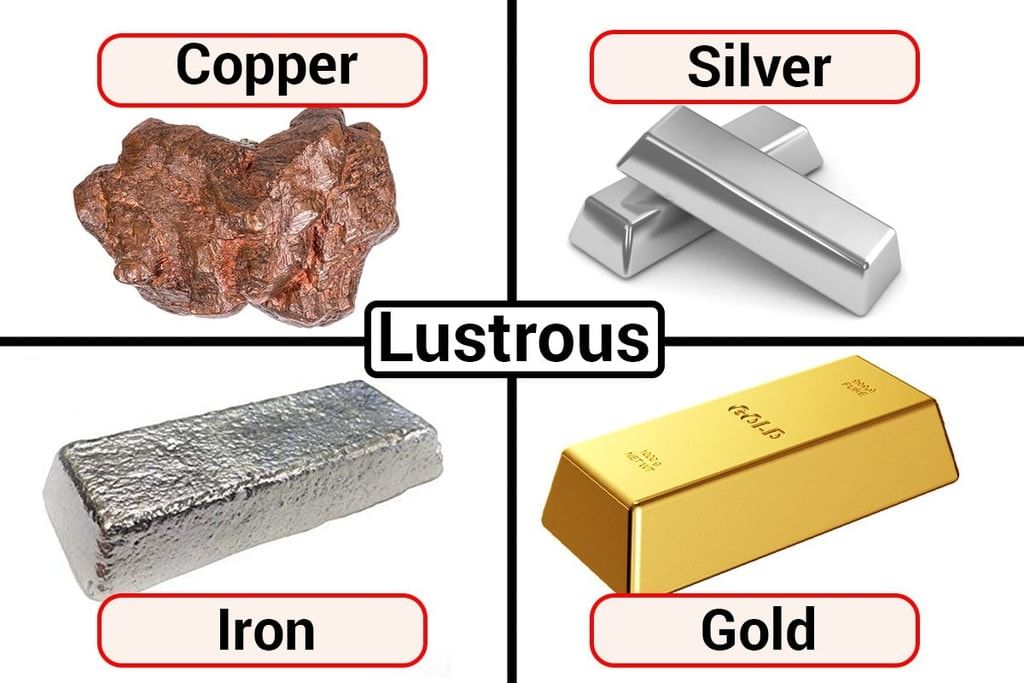Class 6 Science Chapter 2 Question Answers - Sorting Materials into Groups
Very Short Question Answers:
Q1: Metals have lustre. (TRUE/FALSE)
TRUE
 Examples of lustrous metals
Examples of lustrous metals
Q2: Give two examples of objects made up of metals.
Lock and steel glass.
Q3: Wood and copper both show lustre. (TRUE/FALSE)
FALSE
Q4: Write any two properties of a material.
Hardness and soluble or insoluble.
Q5: What are soft materials?
Soft materials are those which can be compressed or scratched easily.
Q6: Give two examples of soft material.
Cotton and sponge.
Q7: Give two examples of hard material.
Iron and wood.
Q8: Materials can have different properties such as ______________ and ______________.
Lustre and hardness
Q9: A piece of stone is ______________ material. (hard /soft )
Hard
Q10: What type of substances are said to be soluble in water?
Substances that completely disappear or dissolve in water are said to be soluble in water.
Q11: Salt is soluble in water, while sand is not. (TRUE/FALSE)
TRUE
Q12: Gases can also dissolve in water. (TRUE/FALSE )
TRUE
Q13: Name any gas which can be dissolved in water.
Oxygen
Q14: All gases are soluble in water. (TRUE/FALSE)
FALSE
Q15: Dried leaf ______________ on the surface of water. (FLOAT/SINK)
Float
Q16: Blood is ______________. (transparent/opaque)
Ans: Opaque
Q17: Write the name of two objects that can float in water.
Leaf and paper
Q18: Stone will ______________ in water.
Sink
Q19: Chocolates, toys and other items are displayed in a shop in see-through containers that are made of glass or plastic. This explains the property of ____ of glass and plastic.
Transparency
Q20: Those materials through which things can be seen are called ______________.
Transparent
Q21: Materials that cannot be compressed are called ______________ materials.
Hard
Q22: Give two examples of opaque material.
Wooden box and metal container.
Q23: Glass is transparent, and stone is opaque. (TRUE/FALSE)
TRUE
Q24: The material through which objects can be seen but not clearly are known as ______________.
Translucent.
Q25: Wood is transparent. (TRUE/FALSE)
FALSE
Q26: Sugar is soluble in water. (TRUE/FALSE)
TRUE
Q27: Oily patch on paper is______________. ( translucent/transparent)
Translucent
Q28: Sand dissolves in water. (TRUE/FALSE)
FALSE
Q29: What kind of material is said to be opaque?
The materials through which we are not able to see are called opaque.
Q30: Name two materials which sink in water.
Stone and coin
Q31: Water is a ______________ liquid. (transparent/translucent )
Transparent
Q32: Oil is insoluble in water. (TRUE/FALSE)
TRUE
Q33: Which of the following is non eatable item:
Orange, mango, salt, basket ball, tomato
Basket ball
Q34: Find the odd one out:
Iron, Gold, Water, Silver
Water is odd one, as rest all are metals
Q35: Which among the following are transparent:
Iron, Water, glass, wood
Water, glass
Q36: Air is transparent. (TRUE/FALSE)
Ans : TRUE
Q37: Eraser has lustre. (TRUE/FALSE)
FALSE
|
100 videos|261 docs|49 tests
|
FAQs on Class 6 Science Chapter 2 Question Answers - Sorting Materials into Groups
| 1. How can materials be sorted into groups? |  |
| 2. Why is it important to sort materials into groups? |  |
| 3. What are some examples of materials that can be sorted into groups? |  |
| 4. How does sorting materials into groups help in recycling processes? |  |
| 5. Can materials be sorted into groups based on more than one property? |  |

















